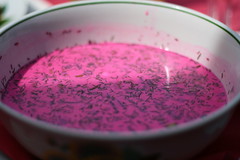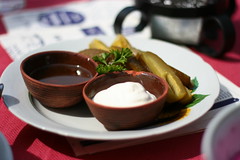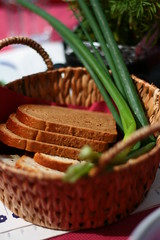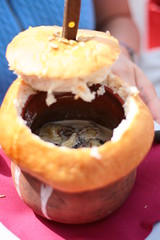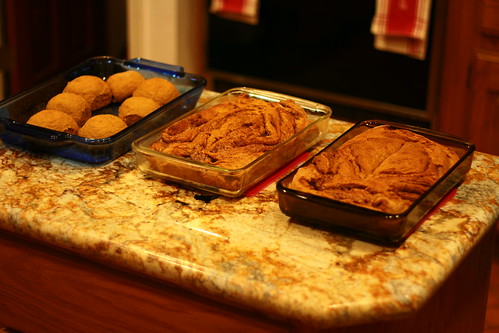Every once in awhile, we have to step aside from obsessng over, photographing, and writing about food to talk about it in more pedestrian terms.
When we visited the United States earlier this summer, we had some sticker shock moments. We sashayed into Safeway and at the check out counter, just about dropped our bags. When we lived in the States, we didn’t usually shop at Safeway, preferring our local Raley’s and supplementing with Whole Foods or other more expensive-but-organic/health food markets. We were a little shocked to find that Safeway’s prices were almost as high as Whole Foods.
Meeting a fellow Californian this week, we were surprised when she bemoaned the cost of living here in Glasgow. Sure, we agreed with her about the cost of housing — trying to find decent digs near the University is a soul-destroyingly painful process, which involves a lot of walking and a lot of shudders of disgust at the “tips” in which some people live –, and we also agreed with her about the price of clothing — it’s definitely a more expensive world without Old Navy or the boundless inexpensive options of the Burlington Coat Factory, etc. (but it may be that clothing is of better quality here? Not sure — haven’t bought that much yet.) — But when she said that food prices were horrendous, we had to ask, “Eh?”
“Well, where do you shop?” We asked, curious. She named some of the same stores which we patronize — small green grocers, corner shops, Tesco, and Grassroots Organic Market. We nodded and commiserated, but obviously there was something missing from our comprehension. We have often remarked what a good thing it is that food is government subsidized here, and have often wondered whether or not the U.S. should take a page from the 70’s and re-adopt that practice. As high as council taxes are in some areas, and with as much access as there is to pubs and bookies, it’s good that feeding people isn’t a major hardship.
Later, we watched this person purchase a few things for lunch. She had several imported items, including cheeses. She also included avocados for herself and her child, who is about three. When we looked at her purchases, understanding dawned.
Most of the time, we make a conscious choice to know the origins of our food. This doesn’t mean we’re trying to be on first-name basis with every farmer in the country (why would they want to be bothered with us?), but that we are trying to eat what’s here, not what’s from home, and live within the local economy. Avocados we adore, but we eat them infrequently, as they’re not grown here and are rarely sourced inexpensively, so they’re just not cheap. I imagine if this family tries to eat as they did in California, with tons of fruit and avocados for every meal, Glasgow must be very spendy for them, indeed.
A UK Guardian piece this past week on wasting food touched off some other thoughts for us — it’s well worth reading. The article talks about not only how to spend less, but how to waste less. It suggests avoiding shopping at supermarkets or using two-for-one offers when one only needs one thing. Rediscovering packed lunches for work or school, bulk buying non-perishables, and reacquainting oneself with one’s freezer are also put forth as viable alternatives to overspending and wasting. The suggestion we loved the most was ‘Cook.’ Not a problem!
We haven’t yet gotten used to the strange looks we get from people our age who find out that most meals we create from scratch at home. I know people who categorically deny that they can eat leftovers — as if leftovers entering their systems are a physical impossibility. Maybe it’s all in how we were raised, but as we open our fridge today — and find it mostly empty — we know it’s time to make some creamy mushroom soup, cook up a pot of beans and bring out Sadie, our starter, and prod her into providing us with another loaf of bread. It doesn’t mean that it’s time to go out! — We’ve eaten out quite a bit in the past week, and have found that we must be going to the wrong places, because restaurant food is not as satisfying as what we eat at home. For folks who years ago used to spend into four figures every year on Thai food alone, this is good news.
If we were able to pass on a helpful suggestion to our new acquaintances from California, it would be to find a restaurant supply store. Costco, of course, is a great place for those bulk non-perishables, but if you don’t need fifty-seven rolls of TP, and don’t have the storage space for it (like we don’t!), it can be daunting. Still, it one needs, for instance, a large bottle of maple syrup, it’s a great option.
Our well-loved Matthew’s is a restaurant supply store for Asian markets all over the city, and the produce may not be spotlessly beautiful, but it’s really inexpensive, and we’ve come away simply laden with veggies bound to be washed and prepped and frozen.
For the most part, we’ve discovered that food here is fairly affordable when we don’t try and pretend we’re still living in California. This isn’t to say we’re not still a little horrified when we think back to the past winter and the times we simply weren’t able to eat the UK root veggies fast enough to prevent them from sprouting — we’ve clued in to the idea of getting a box of veggies in the winter every other week, instead of weekly, so that hopefully we’re not wasting food or money. There are always imperfect days, but we’re making our way toward using things up, wearing them out, making them do… so we don’t have to do without.
Someone asked us how we liked the pickle, sour cream and honey dish we had in Tallinn last week. Though it certainly wasn’t awful, it was unusual enough that we’re still not sure we liked it. The jury’s still confused as to which was the condiment in the group… pickles? Sour cream? Honey? And speaking of condiments, a recent jaunt to the Highlands made us realize that Scottish people outside of Glasgow don’t seem to have mustard on the table and readily available. We have substituted vinegar (that’s part of the taste we’re after in mustard anyway) a couple of times, but we rather like our mustard, and now are considering traveling with a small bottle, just in case…



